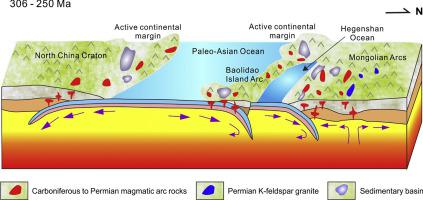当前位置:
X-MOL 学术
›
Gondwana Res.
›
论文详情
Our official English website, www.x-mol.net, welcomes your feedback! (Note: you will need to create a separate account there.)
Late Carboniferous to Early Permian oceanic subduction in central Inner Mongolia and its correlation with the tectonic evolution of the southeastern Central Asian Orogenic Belt
Gondwana Research ( IF 6.1 ) Pub Date : 2020-08-01 , DOI: 10.1016/j.gr.2020.02.016 Hui Chai , Yunfei Ma , M. Santosh , Shengli Hao , Tongwei Luo , Dongqian Fan , Bo Gao , Lebin Zong , Hao Mao , Qingfei Wang
Gondwana Research ( IF 6.1 ) Pub Date : 2020-08-01 , DOI: 10.1016/j.gr.2020.02.016 Hui Chai , Yunfei Ma , M. Santosh , Shengli Hao , Tongwei Luo , Dongqian Fan , Bo Gao , Lebin Zong , Hao Mao , Qingfei Wang

|
Abstract The Late Paleozoic magmatism in central Inner Mongolia provides important insights on the tectonic evolution and crustal growth in the Central Asian Orogenic Belt (CAOB), which formed due to the closure of the Paleo-Asian Ocean (PAO). This paper presents new zircon U Pb ages and Hf isotopic compositions as well as whole-rock geochemical data on a suite of volcanic rocks from the Late Paleozoic Baoligaomiao Formation and coeval intrusions in the Baiyinwula region of the Mongolian Arc. This study revealed that the magmatic sequences evolution includes: (1) early andesites (317–311 Ma) with enrichment in large ion lithophile elements (LILEs), depletion in high field strength elements (HSFEs), and positive zircon eHf (t) values from +9.0 to +15.5, indicating a derivation from enriched mantle; (2) felsic rocks emplaced from 306 Ma to 292 Ma, with relatively lower eHf (t) values from +6.3 to +11.3, implying juvenile crust as the primary magma source; and (3) A-type igneous rocks (280–278 Ma). The comparison of palaeontological, lithostratigraphical, and magmatic evolution in Late Paleozoic between different tectonic units in the eastern part of CAOB has displayed that the subduction of Paleo-Asian oceanic crust caused the opening of the Hegenshan Ocean along the southern margin of Mongolian Arc in Devonian; and the Baoligaomiao Formation volcanic rocks and coeval intrusions have recorded early northwards subduction and subsequent slab rollback of Hegenshan oceanic crust.
中文翻译:

内蒙古中部晚石炭世至早二叠世大洋俯冲及其与中亚造山带东南部构造演化的相关性
摘要 内蒙古中部晚古生代岩浆活动为古亚洲洋(PAO)闭合形成的中亚造山带(CAOB)的构造演化和地壳生长提供了重要见解。本文介绍了蒙古弧白音乌拉地区晚古生代宝力高庙组和同期侵入体的一套火山岩的新锆石U Pb年龄和Hf同位素组成以及全岩地球化学数据。本研究揭示了岩浆层序演化包括:(1)早期安山岩(317-311 Ma),大离子亲石元素(LILEs)富集,高场强元素(HSFEs)耗尽,锆石eHf(t)为正值从 +9.0 到 +15.5,表明源自富集地幔;(2) 306 Ma~292 Ma 侵位的长英质岩,eHf (t) 值相对较低,从 +6.3 到 +11.3,表明幼年地壳是主要的岩浆源;(3) A型火成岩(280~278 Ma)。CAOB东部不同构造单元晚古生代古生物、岩石地层和岩浆演化的对比表明,古亚洲洋壳俯冲导致泥盆纪蒙古弧南缘和根山洋的张开。 ; 宝里高庙组火山岩和同期侵入体记录了河根山洋壳早期向北俯冲和随后的板块回滚。CAOB东部不同构造单元晚古生代岩浆演化表明,古亚洲洋壳俯冲导致泥盆纪蒙古弧南缘和根山洋张开;宝里高庙组火山岩和同期侵入体记录了河根山洋壳早期向北俯冲和随后的板块回滚。CAOB东部不同构造单元晚古生代岩浆演化表明,古亚洲洋壳俯冲导致泥盆纪蒙古弧南缘和根山洋张开;宝里高庙组火山岩和同期侵入体记录了河根山洋壳早期向北俯冲和随后的板块回滚。
更新日期:2020-08-01
中文翻译:

内蒙古中部晚石炭世至早二叠世大洋俯冲及其与中亚造山带东南部构造演化的相关性
摘要 内蒙古中部晚古生代岩浆活动为古亚洲洋(PAO)闭合形成的中亚造山带(CAOB)的构造演化和地壳生长提供了重要见解。本文介绍了蒙古弧白音乌拉地区晚古生代宝力高庙组和同期侵入体的一套火山岩的新锆石U Pb年龄和Hf同位素组成以及全岩地球化学数据。本研究揭示了岩浆层序演化包括:(1)早期安山岩(317-311 Ma),大离子亲石元素(LILEs)富集,高场强元素(HSFEs)耗尽,锆石eHf(t)为正值从 +9.0 到 +15.5,表明源自富集地幔;(2) 306 Ma~292 Ma 侵位的长英质岩,eHf (t) 值相对较低,从 +6.3 到 +11.3,表明幼年地壳是主要的岩浆源;(3) A型火成岩(280~278 Ma)。CAOB东部不同构造单元晚古生代古生物、岩石地层和岩浆演化的对比表明,古亚洲洋壳俯冲导致泥盆纪蒙古弧南缘和根山洋的张开。 ; 宝里高庙组火山岩和同期侵入体记录了河根山洋壳早期向北俯冲和随后的板块回滚。CAOB东部不同构造单元晚古生代岩浆演化表明,古亚洲洋壳俯冲导致泥盆纪蒙古弧南缘和根山洋张开;宝里高庙组火山岩和同期侵入体记录了河根山洋壳早期向北俯冲和随后的板块回滚。CAOB东部不同构造单元晚古生代岩浆演化表明,古亚洲洋壳俯冲导致泥盆纪蒙古弧南缘和根山洋张开;宝里高庙组火山岩和同期侵入体记录了河根山洋壳早期向北俯冲和随后的板块回滚。



























 京公网安备 11010802027423号
京公网安备 11010802027423号